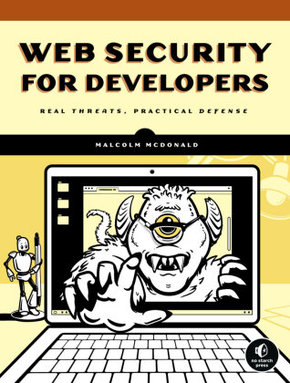
Web Security for Developers - Real Threats, Practical Defense
| Verlag | No Starch Press |
| Auflage | 2020 |
| Seiten | 216 |
| Format | 18,2 x 23,7 x 1,4 cm |
| Gewicht | 429 g |
| Artikeltyp | Englisches Buch |
| ISBN-10 | 1593279949 |
| EAN | 9781593279943 |
| Bestell-Nr | 59327994UA |
Website security made easy. This book covers the most common ways websites get hacked and how web developers can defend themselves.
The world has changed. Today, every time you make a site live, you're opening it up to attack.
A first-time developer can easily be discouraged by the difficulties involved with properly securing a website. But have hope: an army of security researchers is out there discovering, documenting, and fixing security flaws. Thankfully, the tools you'll need to secure your site are freely available and generally easy to use.
Web Security for Developers will teach you how your websites are vulnerable to attack and how to protect them. Each chapter breaks down a major security vulnerability and explores a real-world attack, coupled with plenty of code to show you both the vulnerability and the fix.
You'll learn how to:
Protect against SQL injection attacks, malicious JavaScript, and cross-site request forgeryAdd authentication an d shape access control to protect accountsLock down user accounts to prevent attacks that rely on guessing passwords, stealing sessions,or escalating privilegesImplement encryptionManage vulnerabilities in legacy codePrevent information leaks that disclose vulnerabilitiesMitigate advanced attacks like malvertising and denial-of-service
As you get stronger at identifying and fixing vulnerabilities, you'll learn to deploy disciplined, secure code and become a better programmer along the way.
Inhaltsverzeichnis:
Chapter 1: Let s Hack a Website
Chapter 2: How the Internet Works
Chapter 3: How Browsers Work
Chapter 4: How Web Servers Work
Chapter 5: How Programmers Work
Chapter 6: Injection Attacks
Chapter 7: Cross-Site Scripting Attacks
Chapter 8: Cross-Site Request Forgery Attacks
Chapter 9: Comprising Authentication
Chapter 10: Session Hijacking
Chapter 11: Permissions
Chapter 12: Information Leaks
Chapter 13: Encryption
Chapter 14: Third-Party Code
Chapter 15: XML Attacks
Chapter 16: Don t Be an Accessory
Chapter 17: Denial-of-Service Attacks
Rezension:
"Reads easily and provides essential knowledge to aspiring web developers."
Help Net Security
"You can frame the usefulness of this book several ways: It s well suited to those who are transitioning from development to security. It s also another great security beginner-level read, providing introductions to an array of pen testing tools that will help you do your job better. And finally, it s a terrific resource for developers looking to build more secure applications."
Britt Kemp, Bishop Fox Labs
